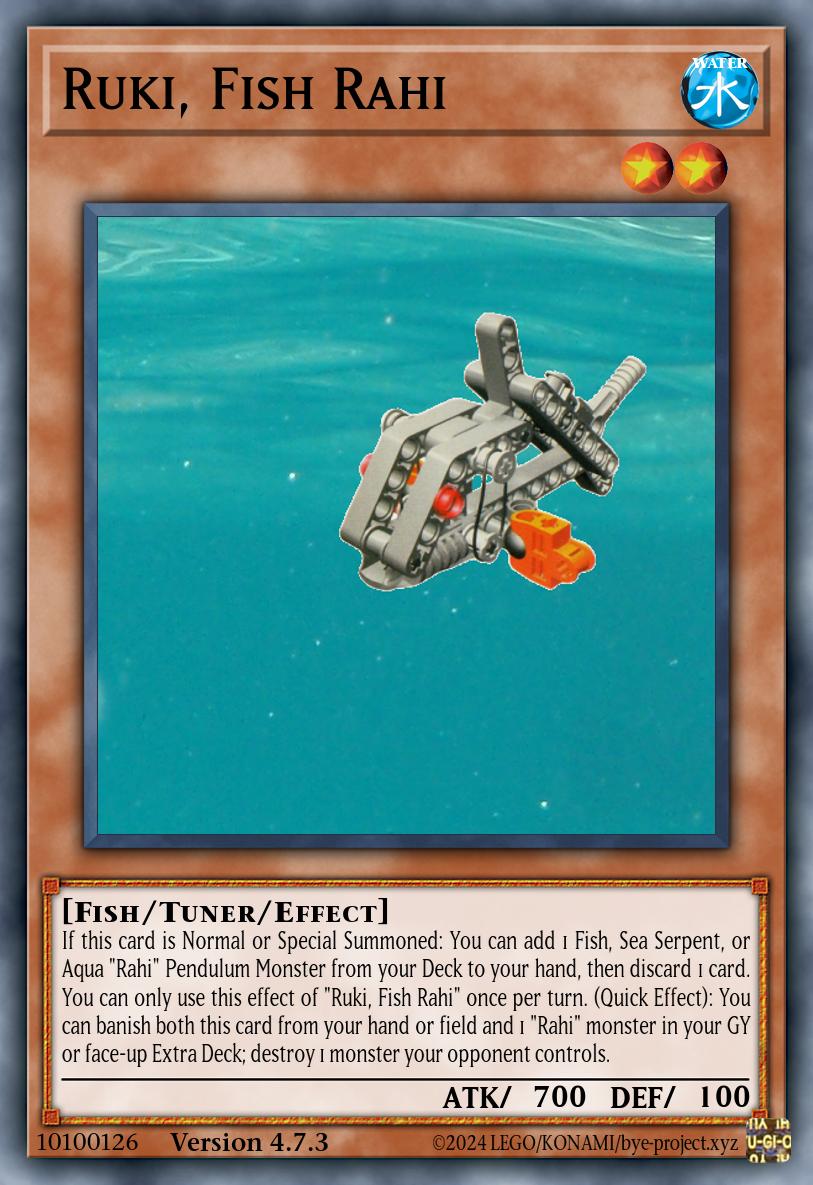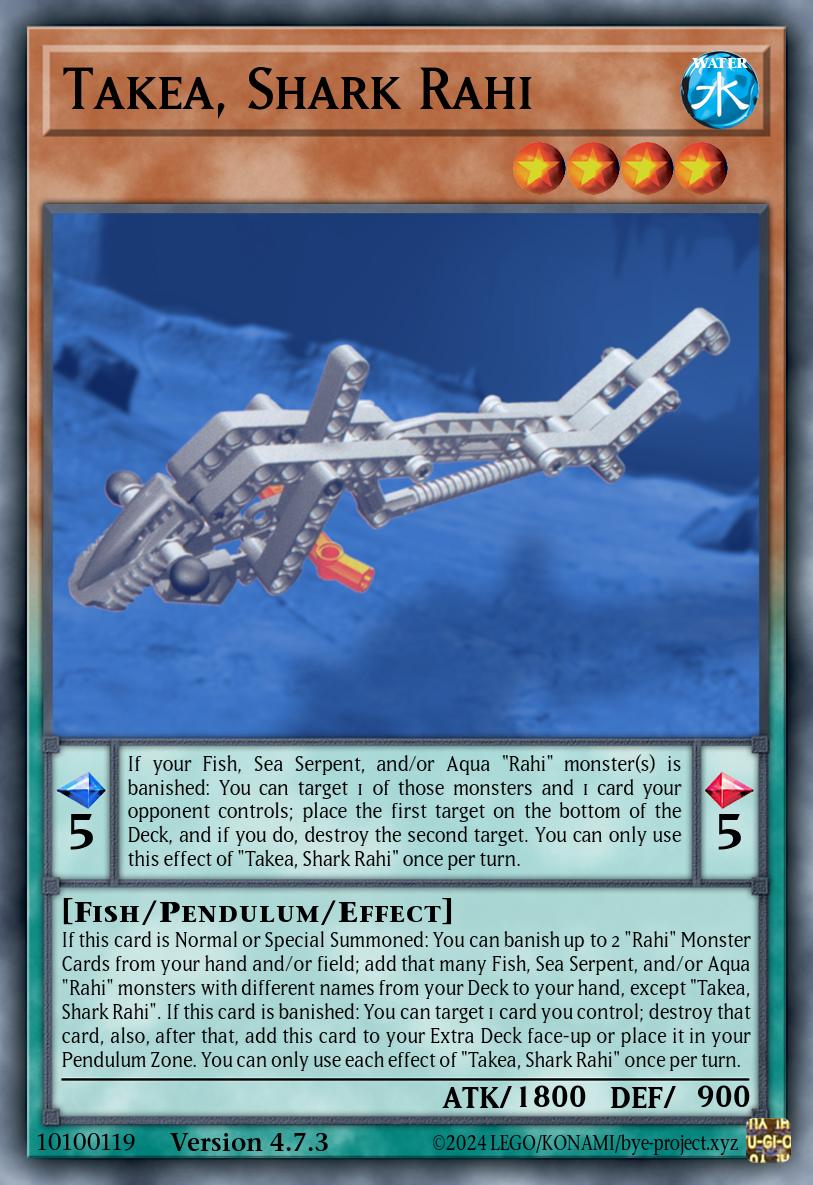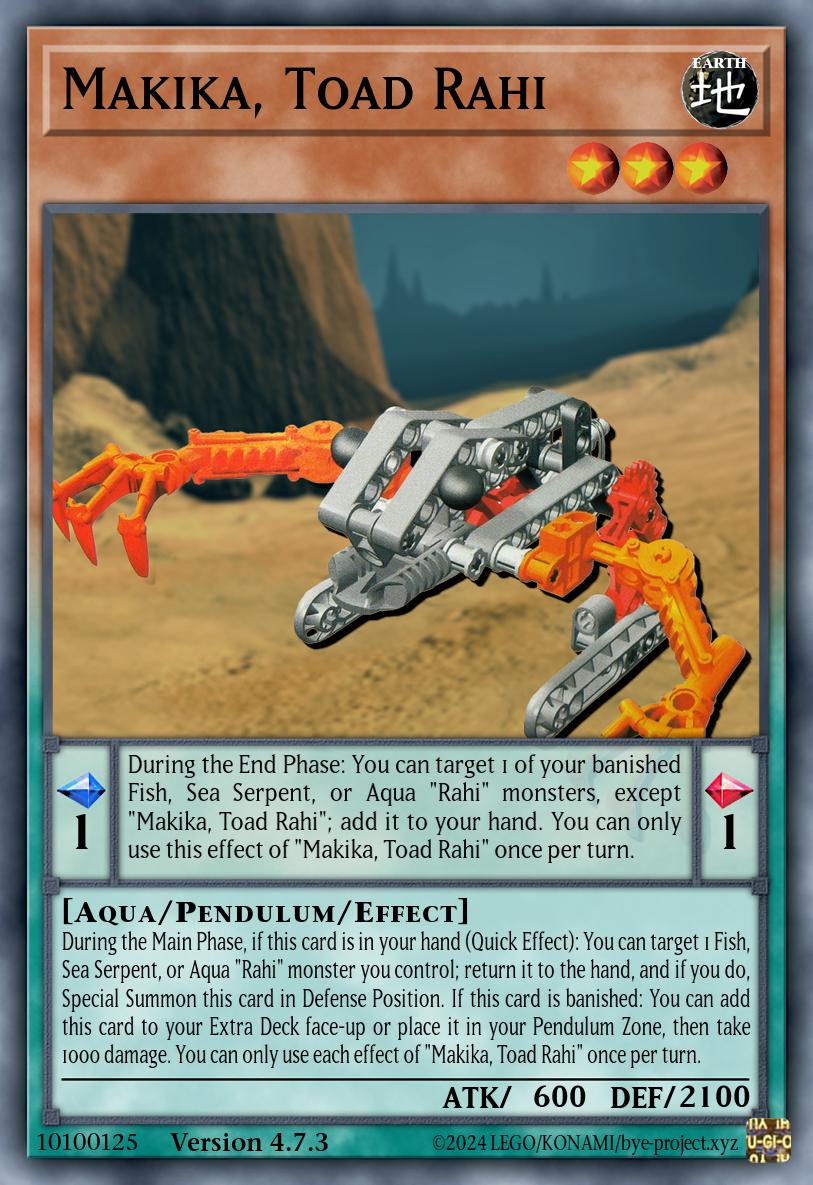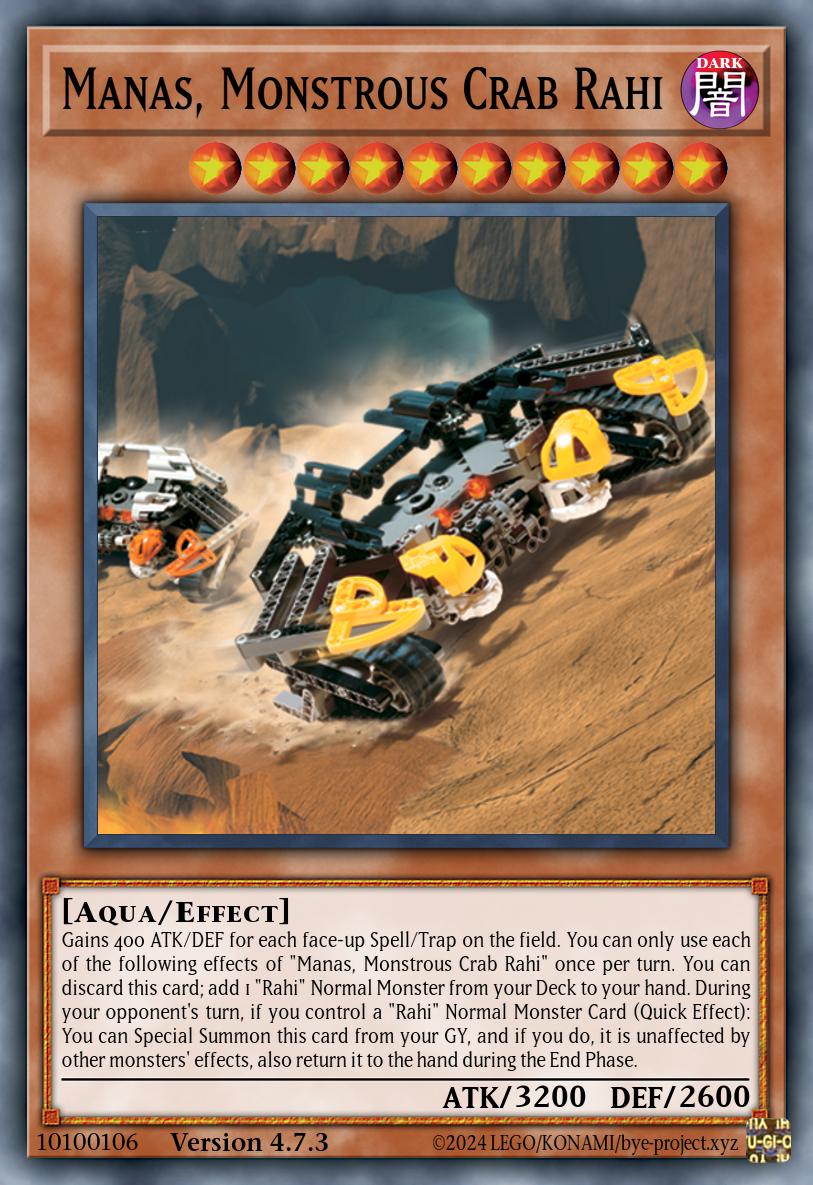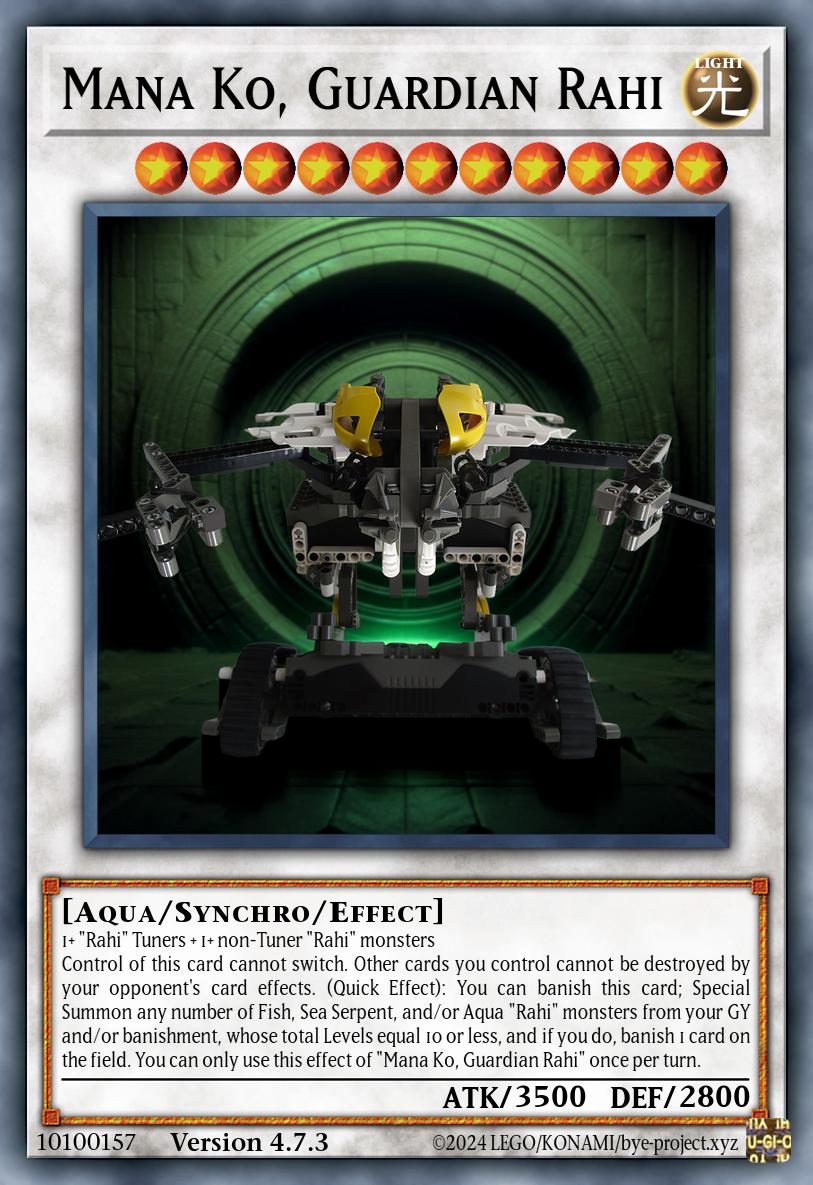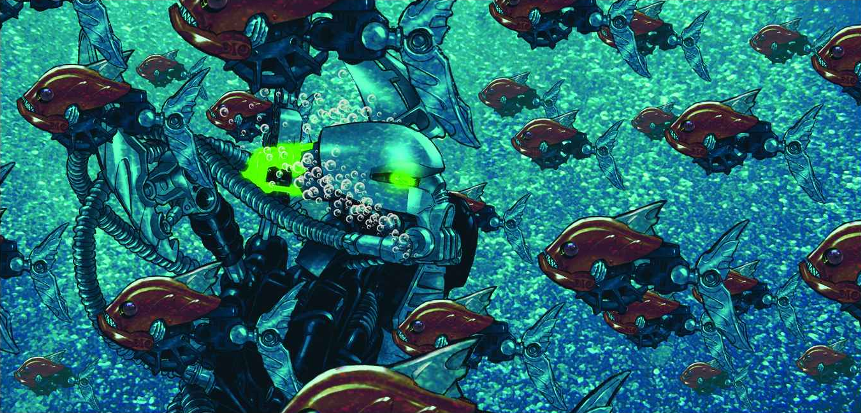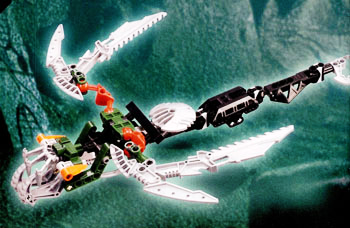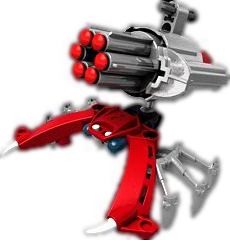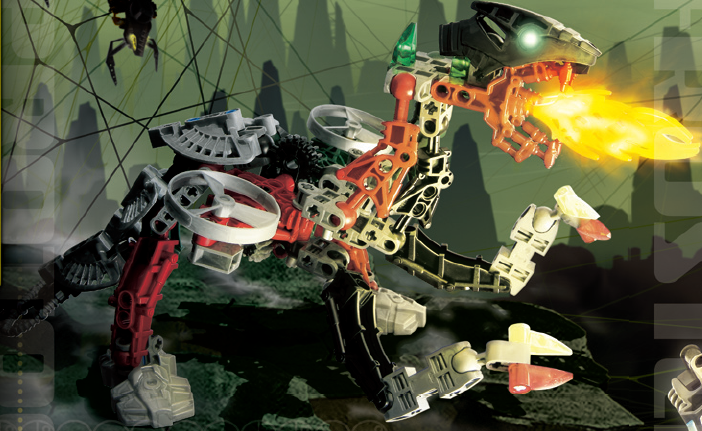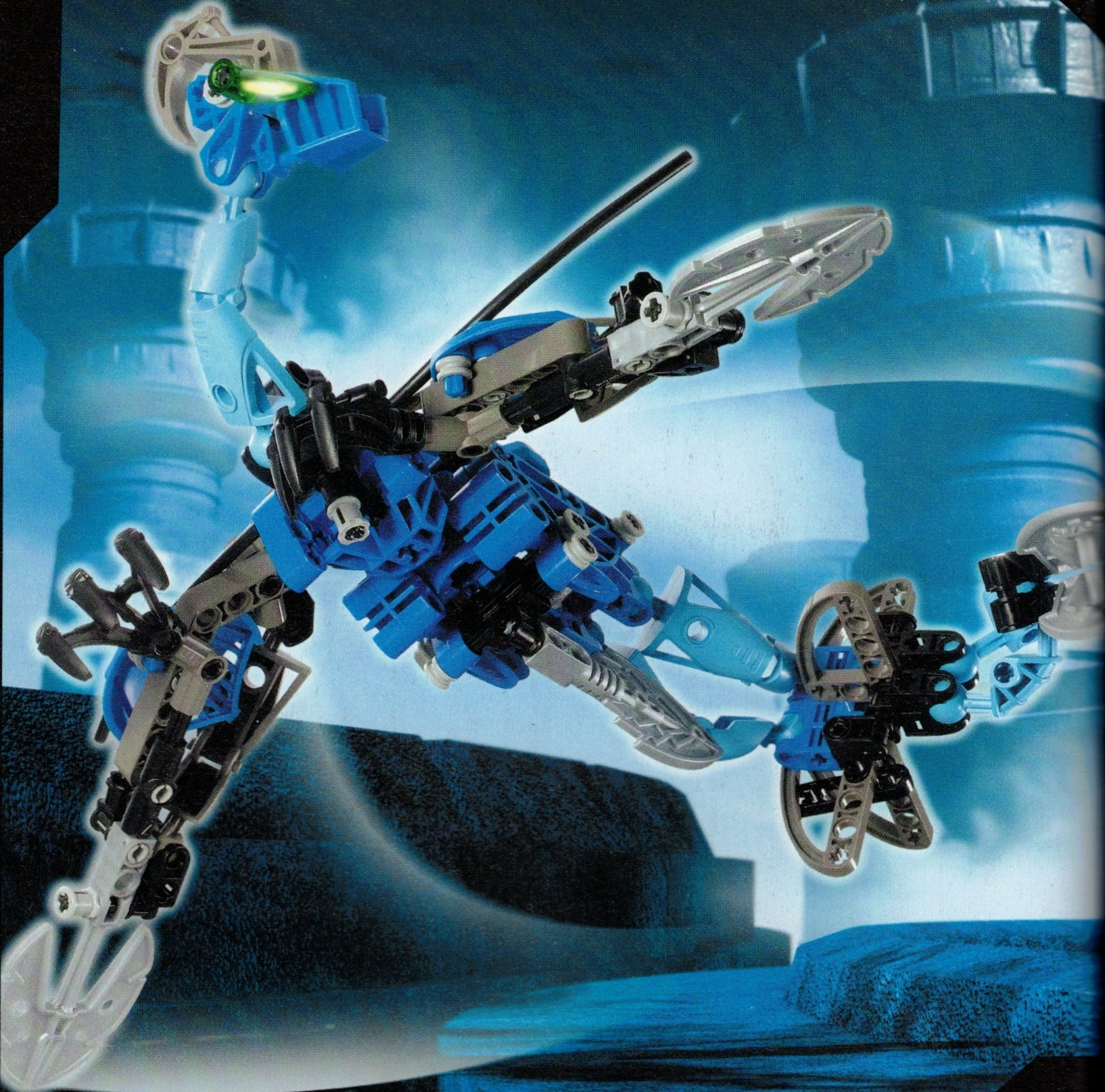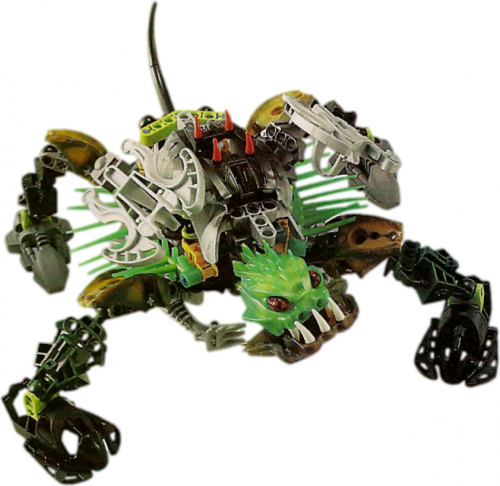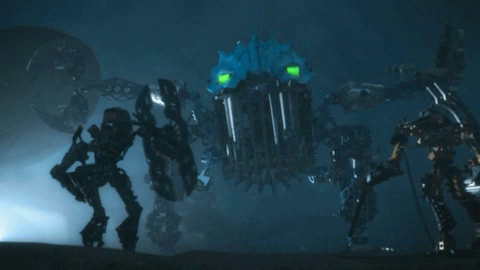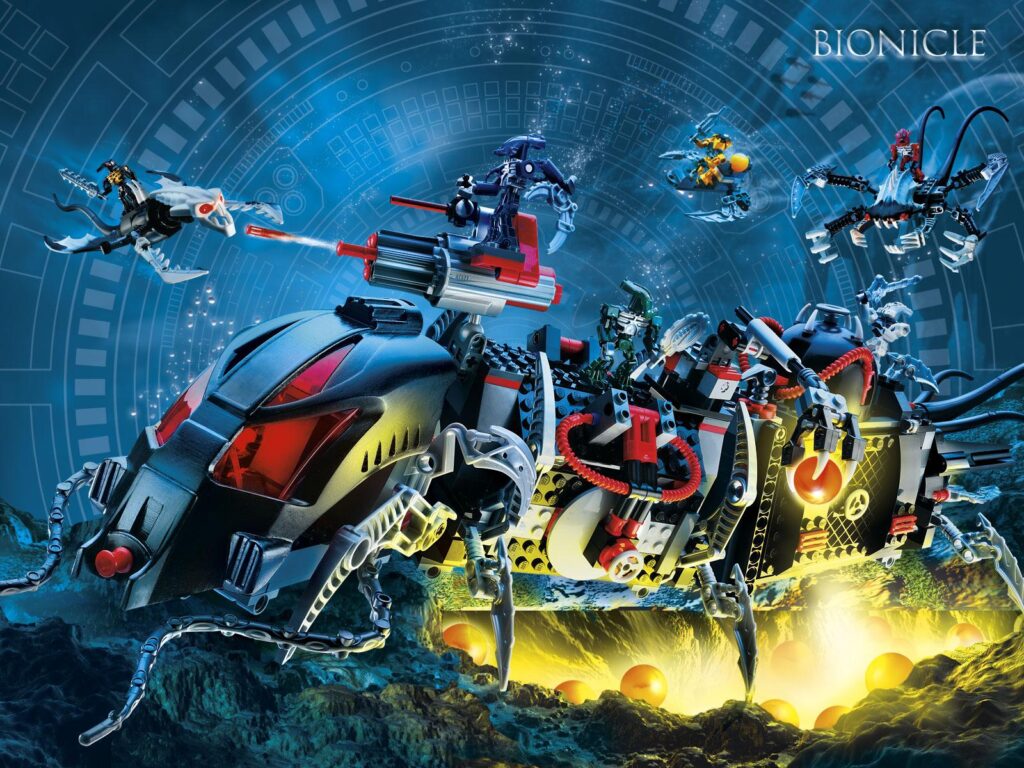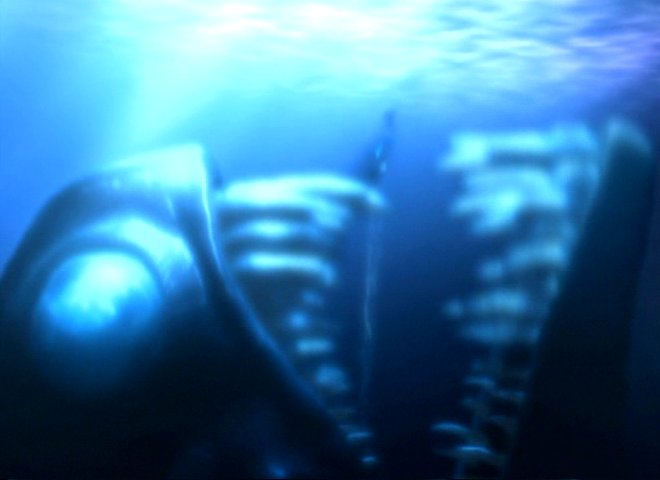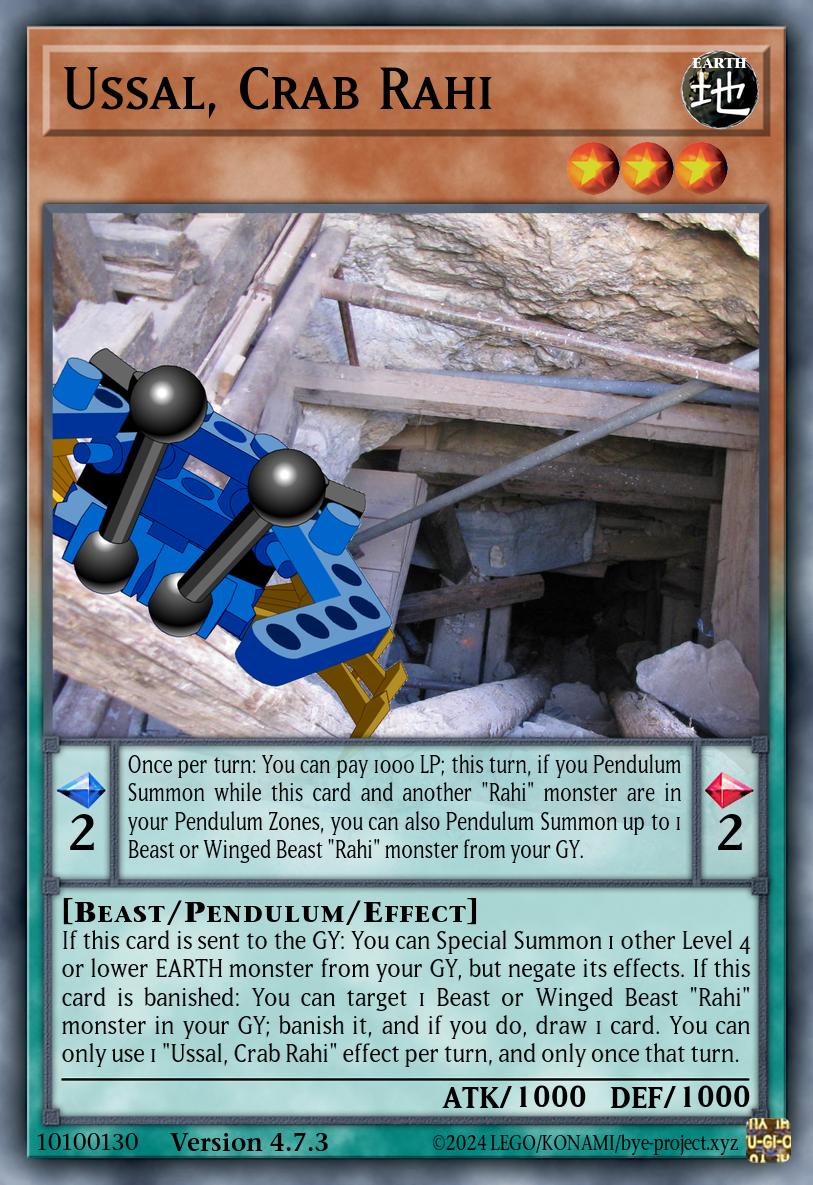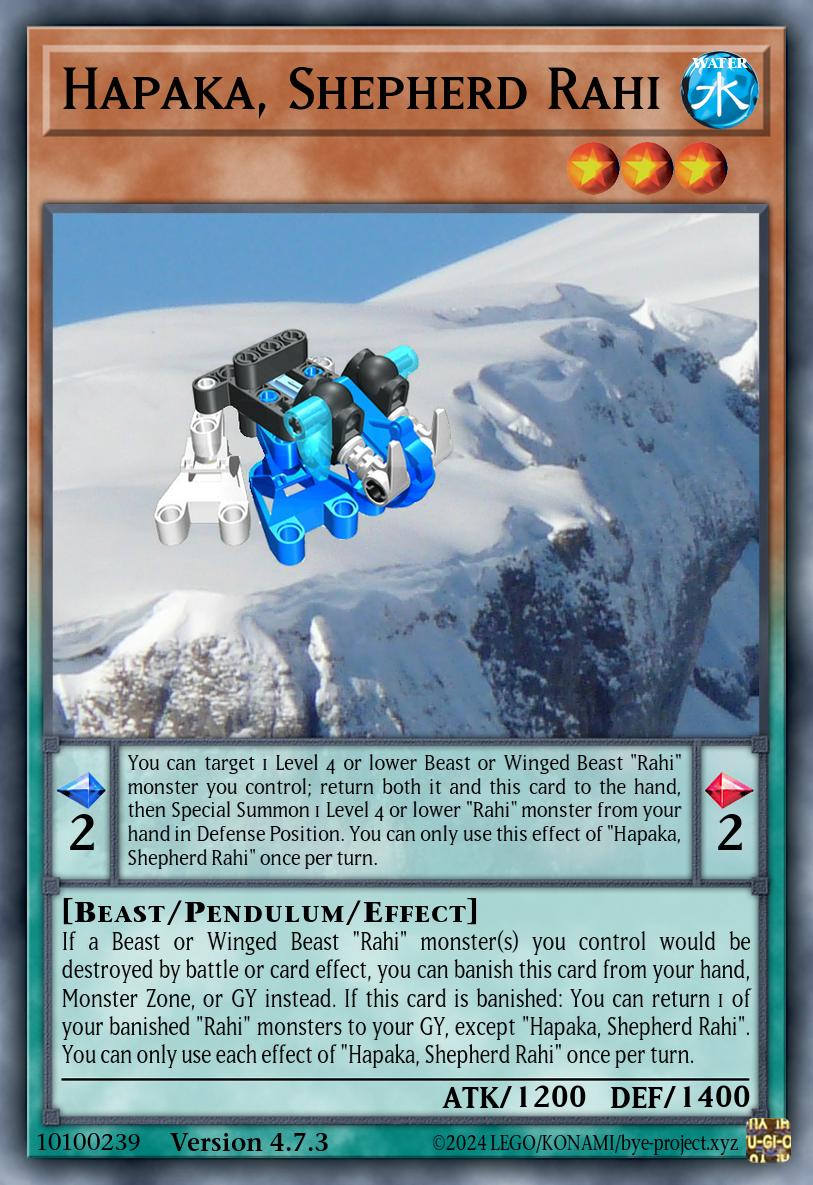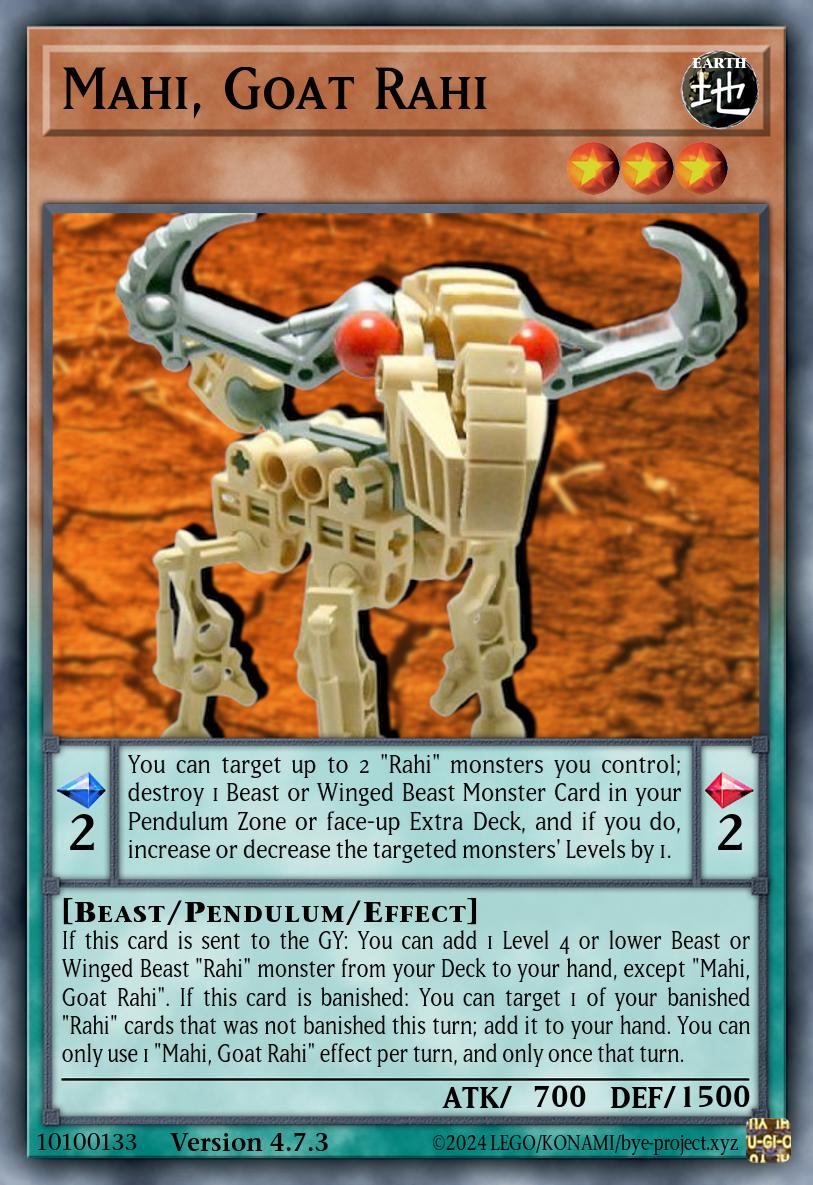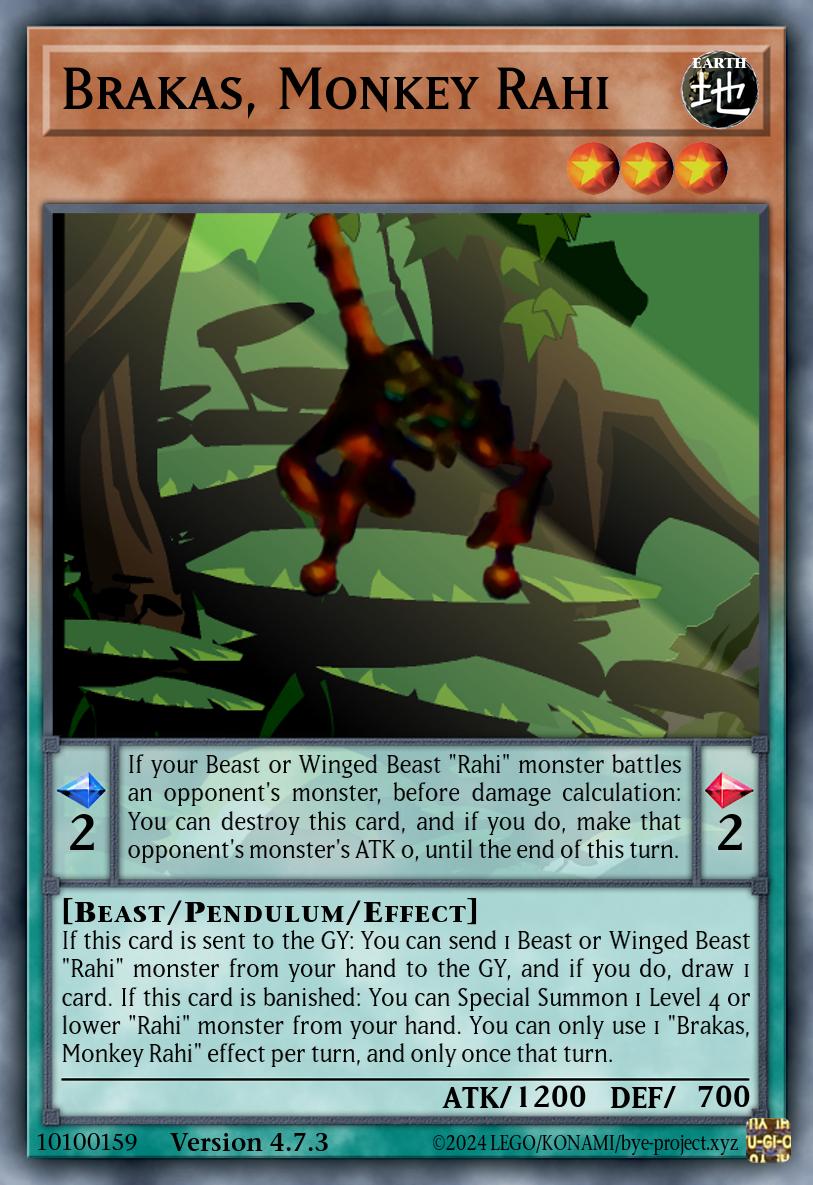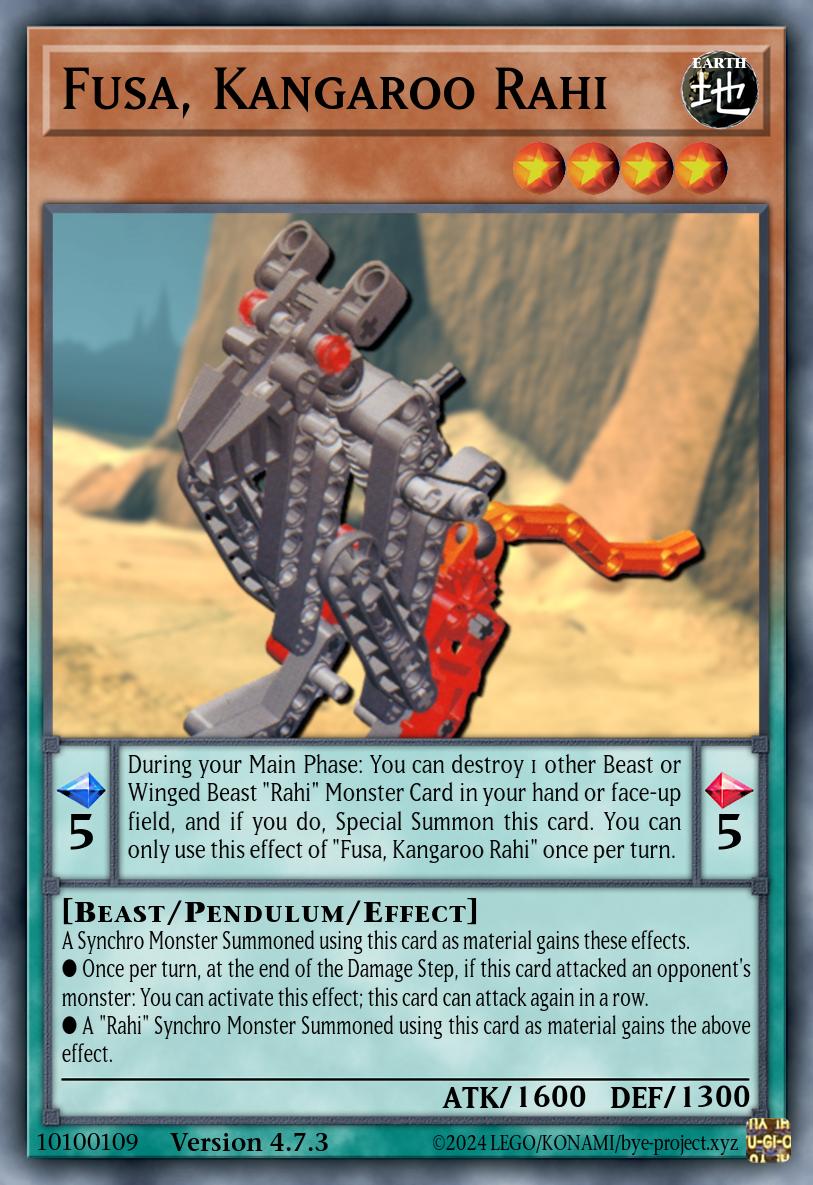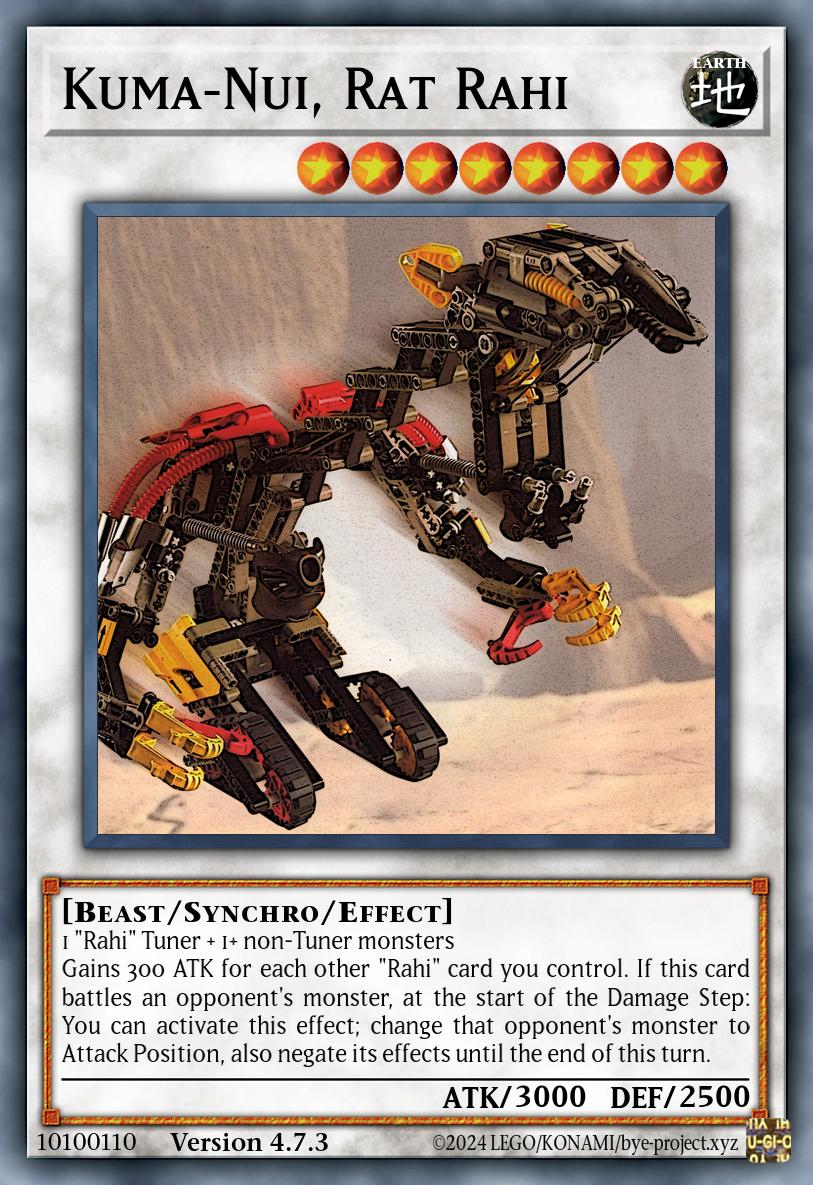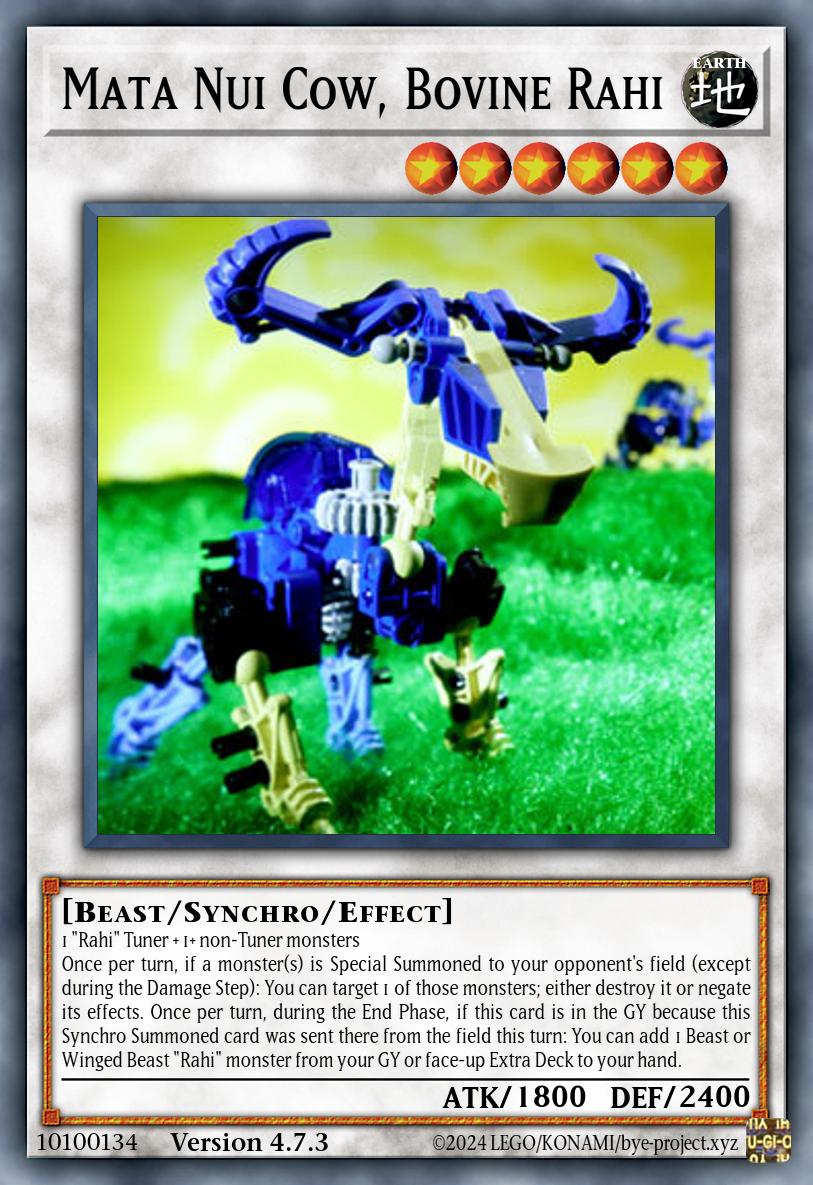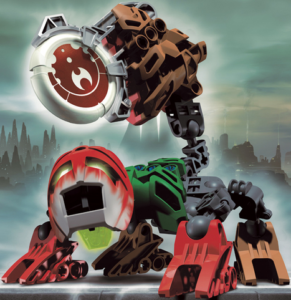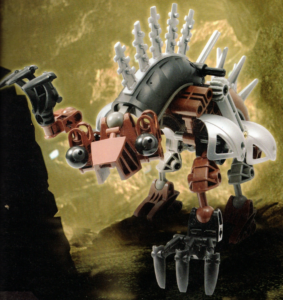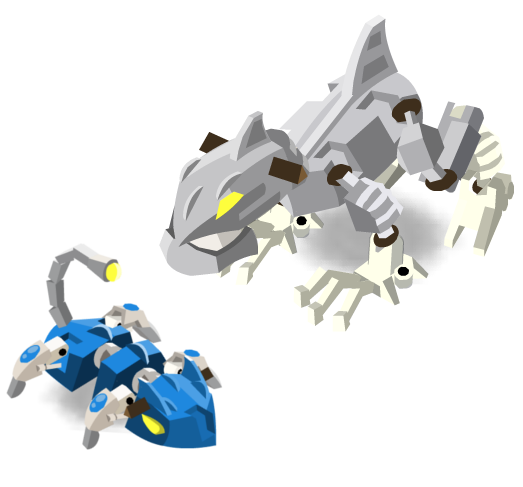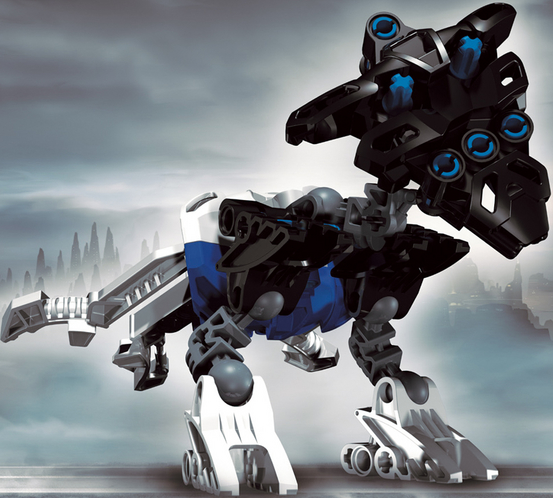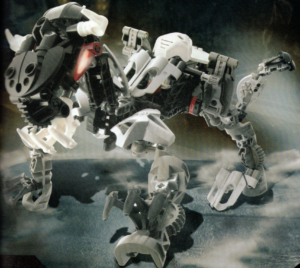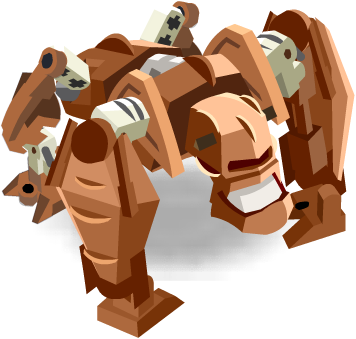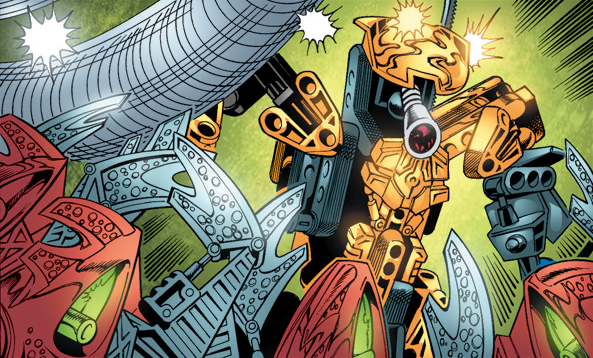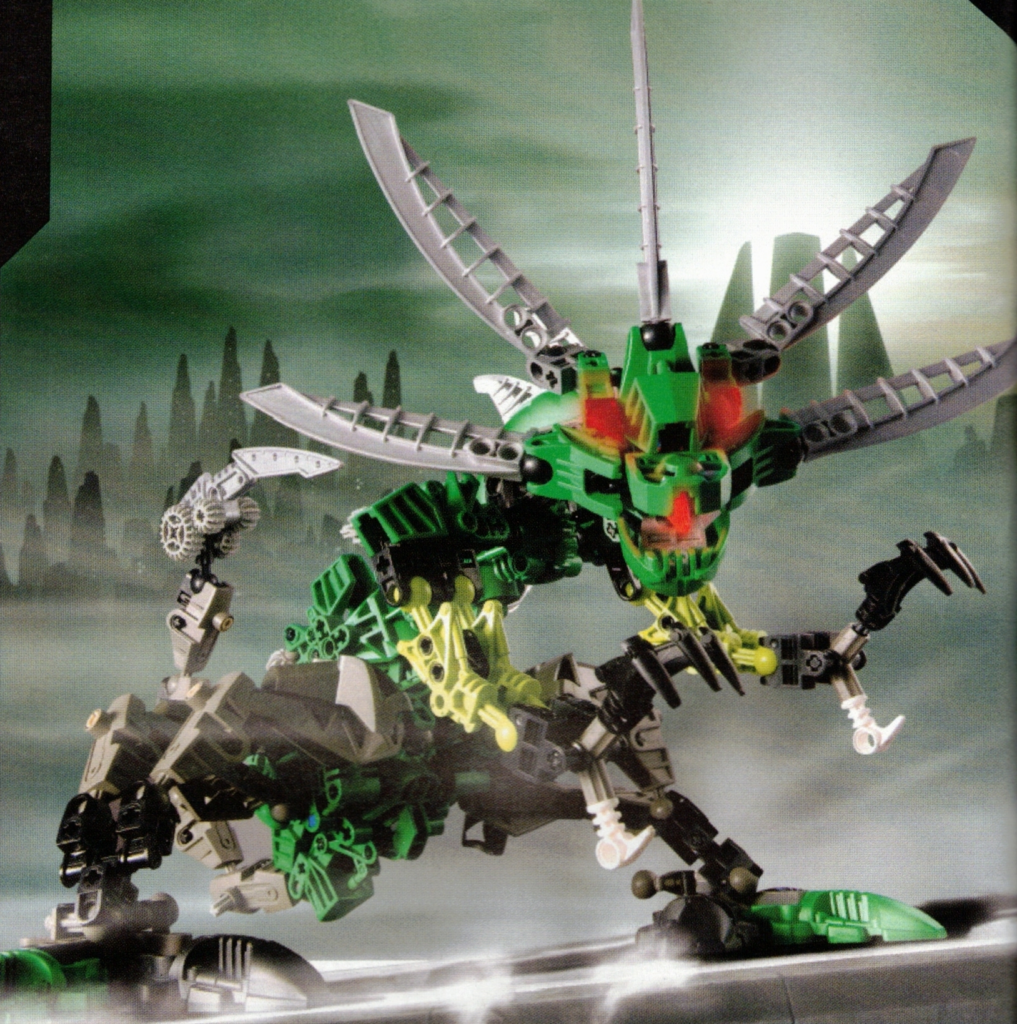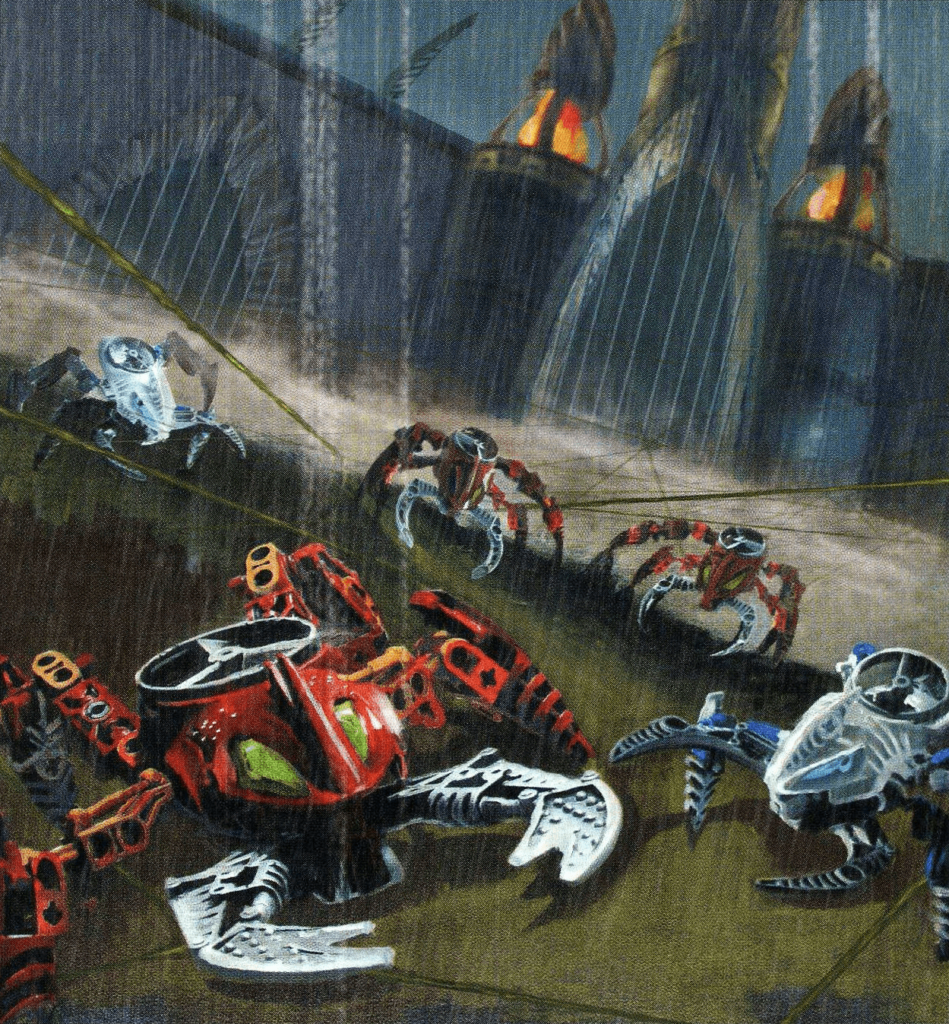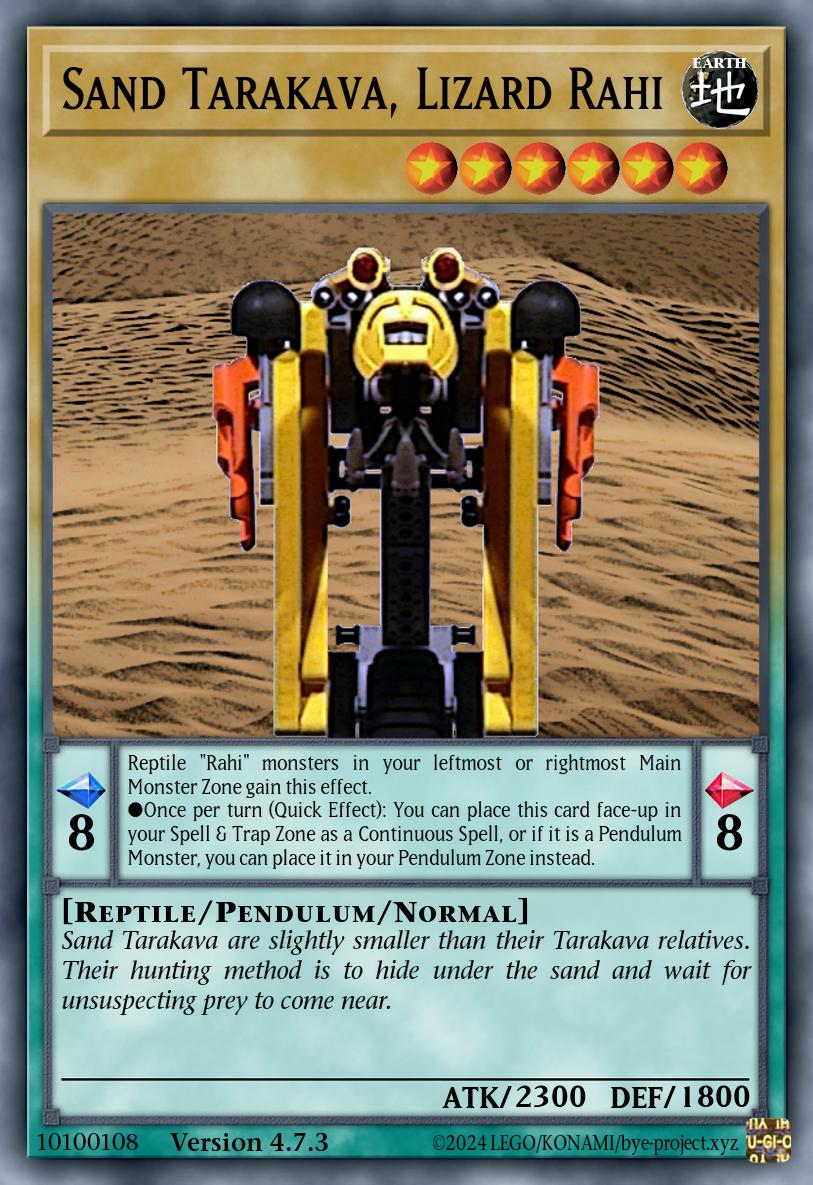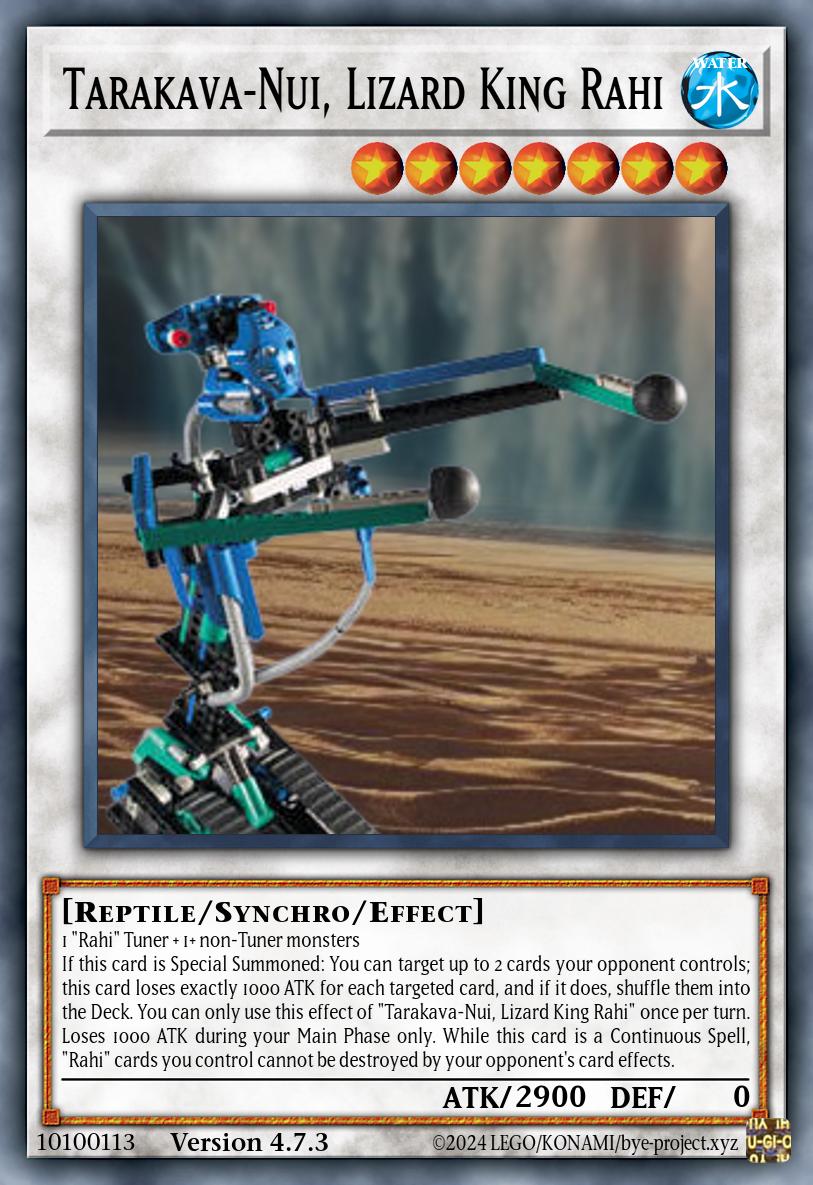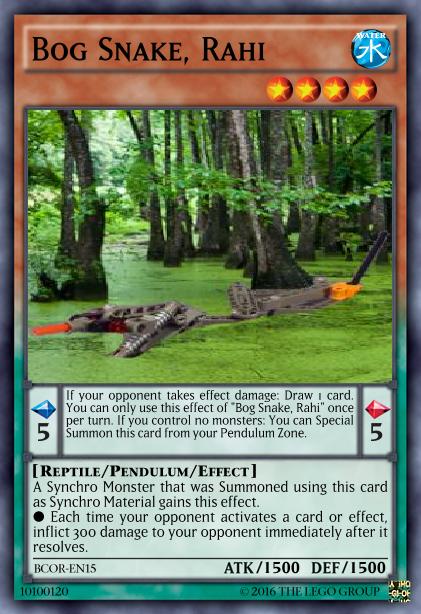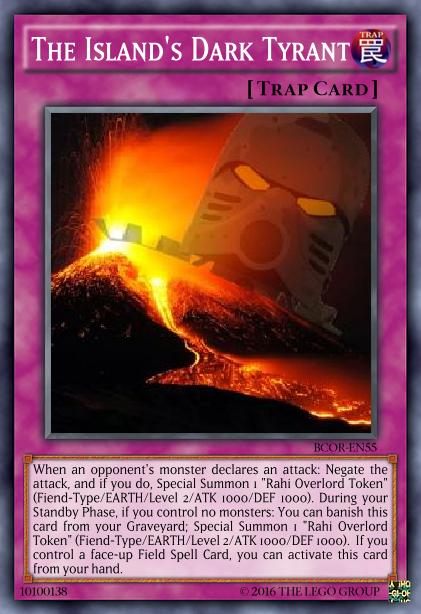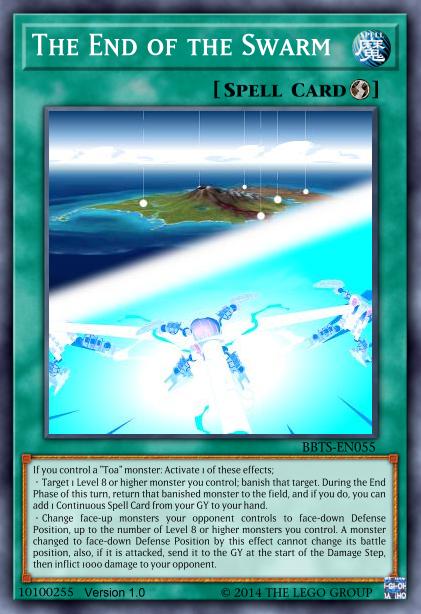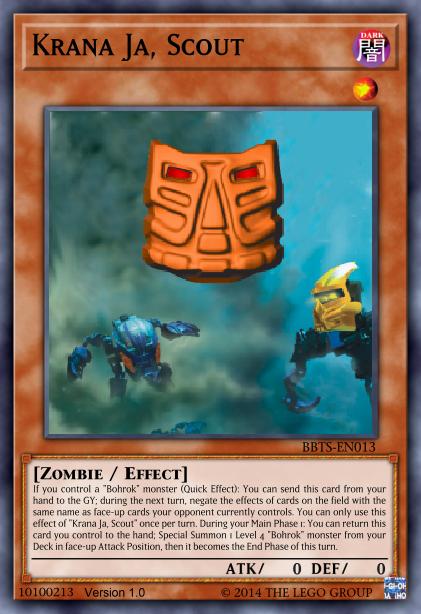And/Or chitinous hides, mandibles, compound eyes – whatever it is that identifies them as Insects.
See also:
- The Rahi Spreadsheet – The data all of this is based on
- The Shapes and Sizes of Rahi – Overview of all Rahi groupings
Current Members
In BCOR, we can find 9 Insect-Type Rahi, spread across all regular Attributes except DARK, with WIND just barely being the most common at 3. Of these Rahi, 4 are Level 2 or lower Tuner monsters, which isn’t all that surprising considering smallness is quite the intuitive Insect trait. The rest doesn’t get all that big either, capping out at Level 6.
Normal Pendulums & Associates

Nui-Jaga, Scorpion Rahi
Normal Pendulum MonsterLevel 5 | Scale 8/8 | EARTH Insect | ATK 2300 / DEF 700[ Pendulum Effect ]
If an Insect “Rahi” monster(s) is Special Summoned to your field (except during the Damage Step): You can target 1 face-up monster on the field; destroy it, and if it was an Insect “Rahi” monster, you can add 1 Insect “Rahi” monster with a different name from your Deck to your hand. You can only use this effect of “Nui-Jaga, Scorpion Rahi” once per turn.
—————————————-
[ Flavor Text ]
Nui-Jaga commonly hunt in packs, which helps to make up for the fact that they are not very fast. One of the creatures will drive prey forward, usually into a canyon, where others wait to strike. Once the target is surrounded, the Nui-Jaga will call to each other. Their cries have been compared to the sound of glass breaking.
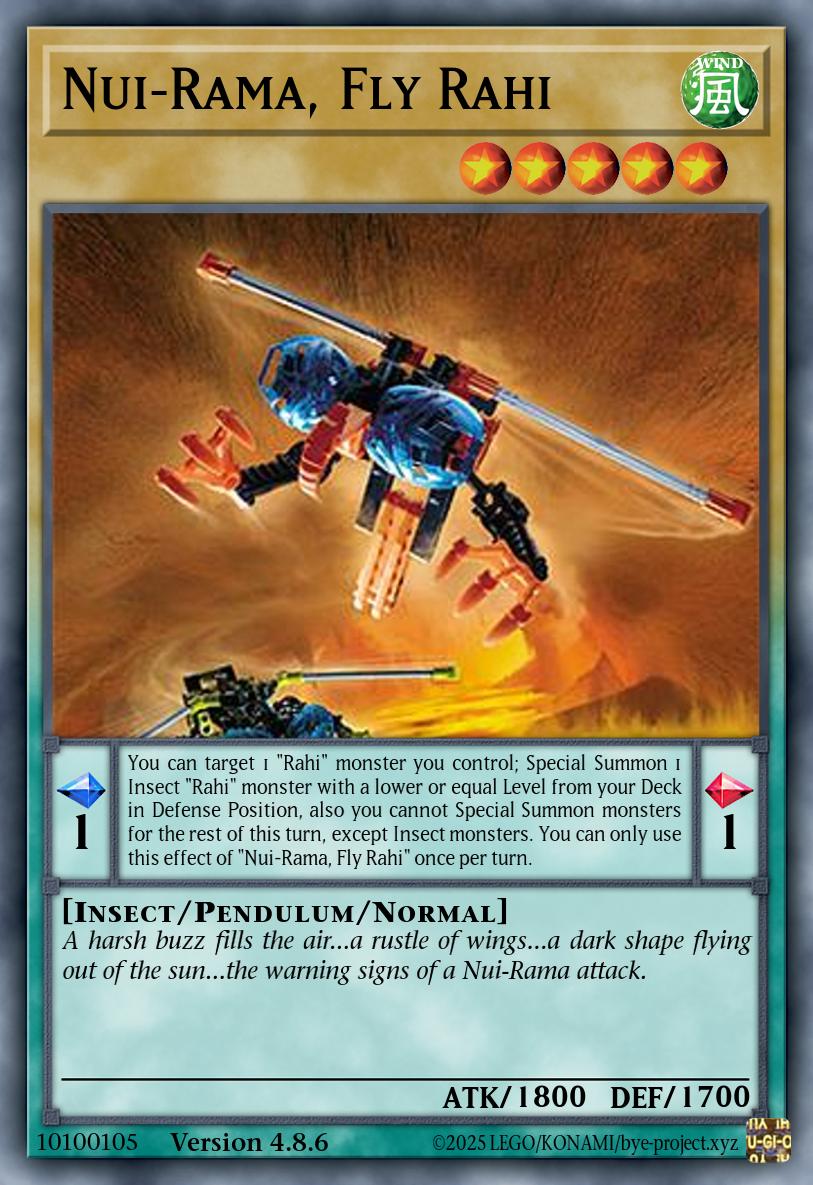
Nui-Rama, Fly Rahi
Normal Pendulum MonsterLevel 5 | Scale 1/1 | WIND Insect | ATK 1800 / DEF 1700[ Pendulum Effect ]
You can target 1 “Rahi” monster you control; Special Summon 1 Insect “Rahi” monster with a lower or equal Level from your Deck in Defense Position, also you cannot Special Summon monsters for the rest of this turn, except Insect monsters. You can only use this effect of “Nui-Rama, Fly Rahi” once per turn.
—————————————-
[ Flavor Text ]
A harsh buzz fills the air…a rustle of wings…a dark shape flying out of the sun…the warning signs of a Nui-Rama attack.
Nui-Jaga and Nui-Rama form the only pair of Rahi to currently rely on the Insect type, in this case to get the same standard Pendulum enhancements that Muaka and Kane-Ra have over at the Beasts. Additionaly, the former recycles a monster while popping a Pendulum Scale for synergy with the destruction-based subtheme (you can really tell how poorly thought out that was when a card that demands Insects interacts in a way not relevant to a single other Insect Rahi), and the latter does some good old swarming.
Both of these effects are useful, but more in a generic way that doesn’t really suggest any particular design direction for the Type as a whole. I guess swarming makes some literal sense when you think of Insects, but that alone does not a gameplan make.
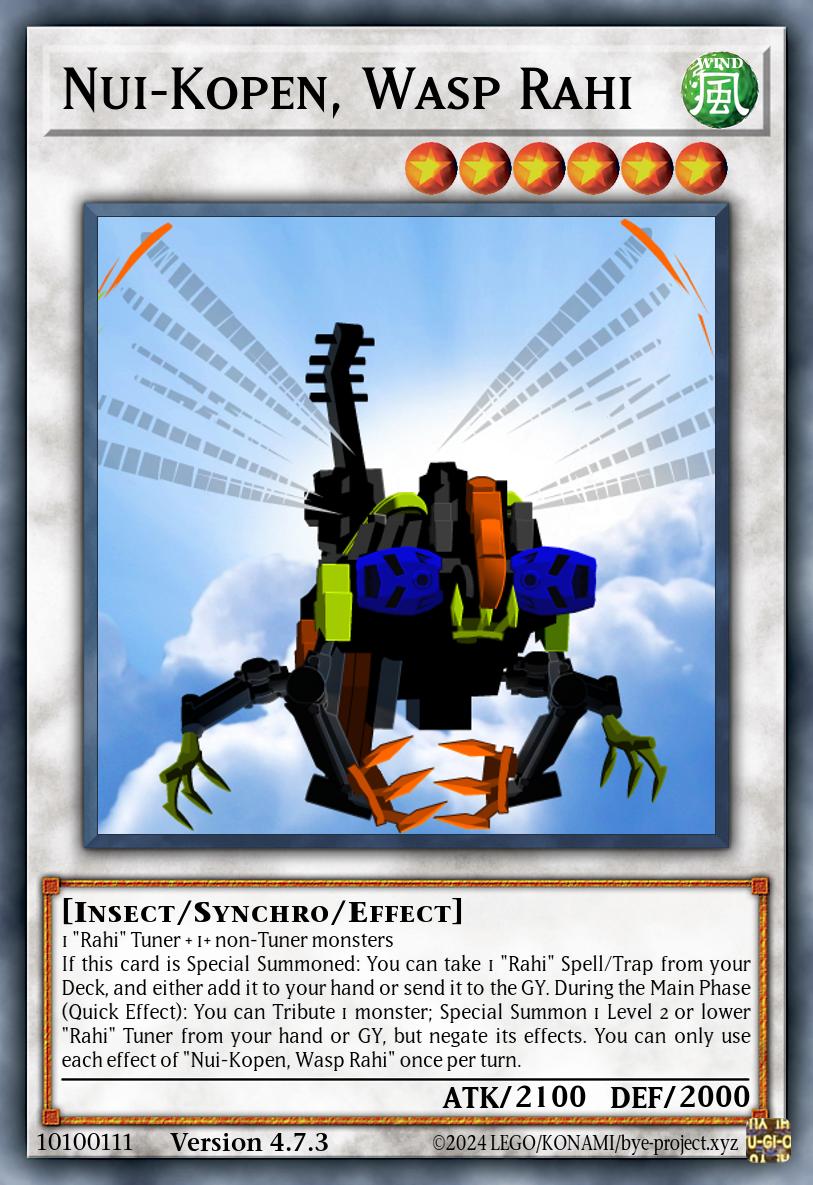
Nui-Kopen, Wasp Rahi
Synchro Effect MonsterLevel 6 | WIND Insect | ATK 2100 / DEF 20001 “Rahi” Tuner + 1+ non-Tuner monsters
If this card is Special Summoned: You can take 1 “Rahi” Spell/Trap from your Deck, and either add it to your hand or send it to the GY. During the Main Phase (Quick Effect): You can Tribute 1 monster; Special Summon 1 Level 2 or lower “Rahi” Tuner from your hand or GY, but negate its effects. You can only use each effect of “Nui-Kopen, Wasp Rahi” once per turn.
The matching Synchro upgrade is the Nui-Kopen, which implements a very fancy method of stealing a monster or Special Summoning even more Rahi from the Deck. One option references the role it played in Lewa getting an infected mask in MNOG and the other fits into the swarming theme, so this seems sensible enough in principle.

Fikou, Spider Rahi
Tuner Effect MonsterLevel 1 | EARTH Insect | ATK 600 / DEF 400If this card is in your hand or GY: You can target 1 Level 2 or higher “Rahi” monster you control; reduce that target’s Level by 1, and if you do, banish this card, then Special Summon 1 “Fikou, Spider Rahi” from your hand or Deck. You can only use this effect of “Fikou, Spider Rahi” once per turn.
In case you were wondering why the Synchro upgrades are always one Level higher than the base forms, it’s because of the Fikou, a Level 1 Tuner that brings out other copies of itself by draining a Level from a Rahi on the field. Which technically means you’d end up with the same total Level rather than +1, so I may not have entirely done the math to the end. Still, I really like the idea of this effect, and again it provides another way of swarming.
Handtraps
Other than occuring in swarms, Insects have a reputation for being annoying as hell, so it’s only fair that we find a relatively high concentration of the Level 2 handtrap Rahi in this Type.

Hoto, Firebug Rahi
Tuner Effect MonsterLevel 1 | FIRE Insect | ATK 600 / DEF 300If this card is in your hand (Quick Effect): You can banish 1 “Rahi” monster from your GY or face-up Extra Deck; Special Summon this card, and if you do, you can destroy 1 Spell/Trap your opponent controls. You can only use this effect of “Hoto, Firebug Rahi” once per turn.
The Hoto is your Spell/Trap removal, with the built-in benefits of banishing and not letting the targeted card be activated in response, since the cost would otherwise be pretty high for such an effect.

Electric Bug, Zapping Rahi
Tuner Effect MonsterLevel 1 | LIGHT Insect | ATK 600 / DEF 300If this card is in your hand (Quick Effect): You can banish 1 “Rahi” monster from your GY or face-up Extra Deck; Special Summon this card, and if you do, you can negate the effects of 1 face-up monster your opponent controls that has activated its effect on the field this turn, until the end of this turn. You can only use this effect of “Electric Bug, Zapping Rahi” once per turn.
The Lightning Bug, which if the wiki is to be believed should actually be called Electric Bug (they hadn’t figured that out yet when I made BCOR), negates monster effects, and even does so without targeting, which is pretty strong to have as a Quick Effect. In a more functional Rahi archetype, this might honestly be overpowered, but right now it really doesn’t feel that way. Also, only currently implemented LIGHT Insect.

Cliff Bug, Hopper Rahi
Tuner Effect MonsterLevel 1 | WATER Insect | ATK 500 / DEF 500If this card is in your hand (Quick Effect): You can banish 1 “Rahi” monster from your GY or face-up Extra Deck; Special Summon this card, and if you do, you can make 1 face-up monster you control be unaffected by Spell/Trap effects until the end of this turn. You can only use this effect of “Cliff Bug, Hopper Rahi” once per turn.
The Cliff Bug goes in a more defensive direction by just making cards unaffected by some card type. This is actually pretty similar to what Turaga Nokama does in the updated version of BCOT, which is quite fitting due to the Cliff Bug being a Ga-Wahi creature (and the only WATER Insect Rahi for now), but completely accidental. I did not remember this card existed until a good while after I did the overhaul for everything Ga-Koro.
It’s worth noting that in contrast to the Beasts, which had a few monsters that benefit from being banished but no handtraps to do the banishing, the Insects suffer from the opposite problem right now – handtraps, but no banish triggers.
Others
Two more cards remain. First, a single Level 4 Pendulum and the second FIRE Insect Rahi.
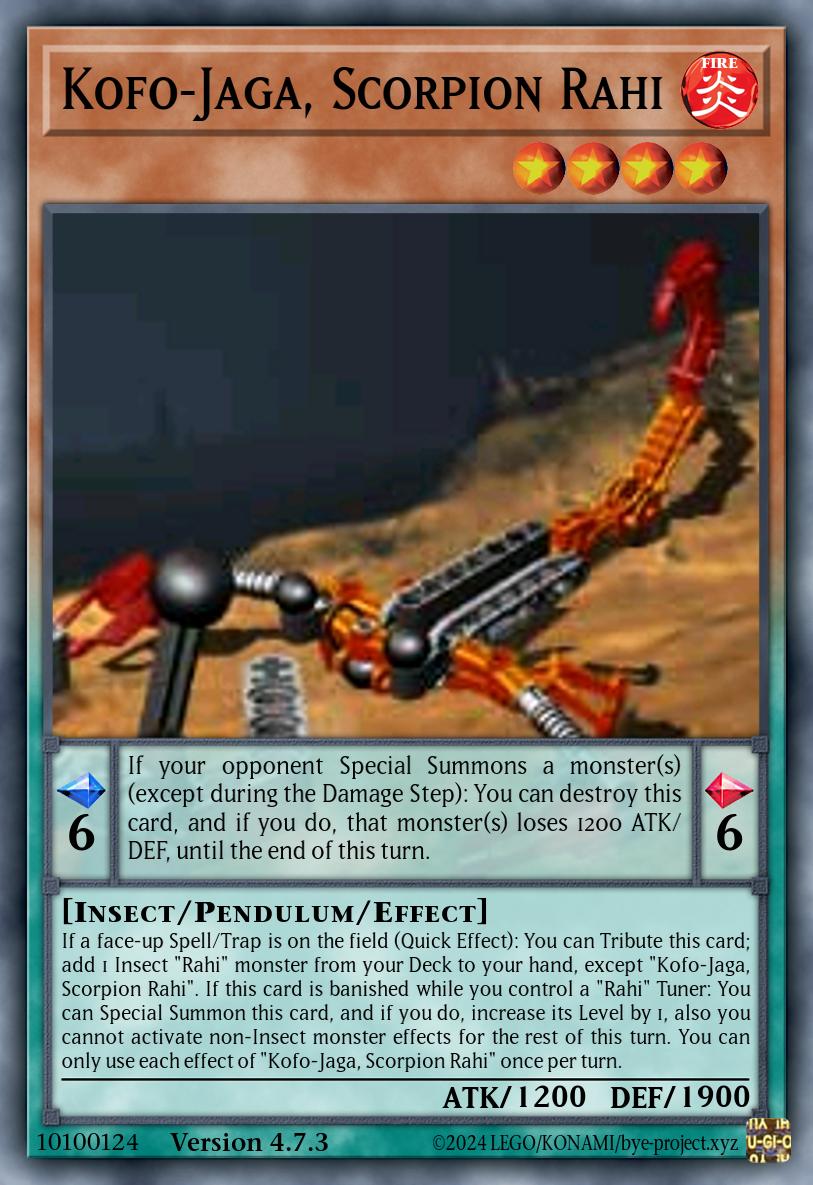
Kofo-Jaga, Scorpion Rahi
Pendulum Effect MonsterLevel 4 | Scale 6/6 | FIRE Insect | ATK 1200 / DEF 1900[ Pendulum Effect ]
If your opponent Special Summons a monster(s) (except during the Damage Step): You can destroy this card, and if you do, that monster(s) loses 1200 ATK/DEF, until the end of this turn.
—————————————-
[ Monster Effect ]
If a face-up Spell/Trap is on the field (Quick Effect): You can Tribute this card; add 1 Insect “Rahi” monster from your Deck to your hand, except “Kofo-Jaga, Scorpion Rahi”. If this card is banished while you control a “Rahi” Tuner: You can Special Summon this card, and if you do, increase its Level by 1, also you cannot activate non-Insect monster effects for the rest of this turn. You can only use each effect of “Kofo-Jaga, Scorpion Rahi” once per turn.
The Kofo-Jaga is the first we’re seeing out of an attempted three-part engine that all grant monsters using them as Synchro material a negate at the cost of shuffling back a Rahi Pendulum from the Extra Deck. In the Pendulum Zone, it has the standard ability to Special Summon itself, and it can search another Rahi Pendulum if a monster is Normal Summoned. You’re basically meant to use this by Normal Summoning a Tuner, searching your other Pendulum Scale, and spamming out a bunch of monsters for a big Synchro play, which is certainly … a bit less reliable following MR4.

Kirikori-Nui, Locust Rahi
Synchro Effect MonsterLevel 3 | WIND Insect | ATK 1400 / DEF 10001 “Rahi” Tuner + 1+ non-Tuner monsters
If this card is Special Summoned, or when this card declares an attack: You can send the top 3 cards of your Deck to the GY; until the end of this turn, this card gains 500 ATK for each “Rahi” card sent to the GY this way. You can only use this effect of “Kirikori-Nui, Locust Rahi” once per turn. You can banish this card until the Standby Phase of your next turn; destroy 1 card on the field.
Keeping with the theme of Insects being smol, the Kirikori-Nui is a tiny Level 3 Synchro, and one I’m quite fond of. It dumps a Rahi to the GY for cost on summon (potentially triggering various things … that are not Insects), and then can just banish itself for a bit to non-targetingly destroy a card. Probably a bit too slow by modern standards seeing how it’s not a quickie and for some reason comes back during your next End Phase, but still cool.
Potential Members
35 of these little critters still await their implementation, so that’s quite a lot. For the most part, we are looking at tiny Level 1 and 2 monsters, but there’s also a few at Levels 3 and 4 and a decent amount at Level 5 and above, up to legitimate Level 12 candidates. Given the massive skew towards low Levels, it will be interesting to see if we can actually derive a competent strategy from these.
Level 1
Practically every Level 1 monster in the spreadsheet belongs to this Type, boasting a grand total of 11 unimplemented entries.
This includes a wide variety of astonishingly irrelevant critters such as the Acidfly, Bog Leech, and Metallic Hornet – names that probably won’t seem intimately familiar even to dedicated Bionicle fans, because they were each mentioned one single time solely as a comparison for how something sounds or looks or whatever. Given the nigh-zero amount of information that can thus be gleaned from the source material about them, the only reason I could see to implement these is if I really need some extra Level 1s. Which seems unlikely given how many there are here anyway.
Just marginally higher on the relevance scale are Fireflyers and Devourers, whose swarms at least have a smidgen of actual screentime courtesy of an Insect Control Rahkshi. Still, they’re more likely to appear on a Spell/Trap depicting that particular incident in the Archives than as dedicated monster cards. Sand Snipes are one of those curious creatures that only appear in guidebooks, but have a unexpectedly interesting description – in this case, they’re small biting pests with a strange habit of drowning themselves in liquid protodermis. That suicidal nature could well inspire some kind of entertaining self-sacrifical effect.

Meanwhile, the Fikou-Nui is a boss from the cancelled ’01 game, but the fact that visual footage of it exists and its relation to the iconic little orange spider might just mean it will get its share of spotlight in the expansion at some point. Maybe because it’s all black, I once upon a time put together a draft of it as a Rank 1 Xyz Monster, which would be quite a unique niche to fill in the archetype.
And probably the most significant role played by any of these miniature Insects in the actual story goes to the Protodites, microscopic beings who were seen in 2006 both as the building blocks of Zaktan’s body and in massively enlarged form as Protodax. Their ability to split in two when struck could make for a neat monster effect (though kind of limited by only having 3 copies), but since their appearances are so indirect, maybe they’ll also end up relegated to a Spell/Trap slot.
The remaining entries – Worms, Spine Slugs, and Niazesk – are clear DARK monsters and therefore have already been covered in that article.
Level 2
A wide variety of worm-like Rahi can be found noted at this level, among them Spiked Fire Worms, Slime Worms, Feeder Worms, Borer Worms, and Rock Worms. All but the last one are just more rhetorical devices with a single mention in the books, and the Rock Worm’s slightly greater relevance only stems from the fact that the Toa Metru once faced a giant one mutated by Energized Protodermis. So the small one might make it in too at that point, just to have a canon material for bringing out its big version.
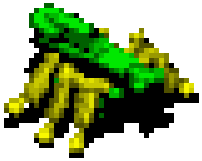
The Electric Spider is exclusively a Quest for the Toa enemy that was retroactively packaged into a common naming pattern with the Electric Bug. If implemented as a card, it would probably do something similar to that little effect-negating handtrap. Maybe negate effects outside the field or something?
And finally, the Frost Leech is another parasite like the aforementioned Spine Slug, except it feeds off heat rather than rage. Perhaps this could translate to some kind of union-like mechanic where the Leech attaches to a monster and slowly “freezes” it.

The surprising takeaway so far is that, even though the numbers suggest a cornucopia of extremely low-Level Insect Rahi, a detailed inspection reveals that almost all the actually relevant ones have been implemented already.
The Visorak Ecosystem
Perhaps the most relevant Insect Rahi are 2005’s Visorak, already featured prominently in the DARK article along with various Rahi directly related to them. Still, it’s not totally impossible that the Visorak could end up getting other Attributes once we reach them, so let’s quickly go over them in the context of Insects as a whole too.
The Visorak themselves would be Level 4 monsters that, if not DARK, would be spread across FIRE, WATER, EARTH, and WIND as per their color schemes. The main features I have currently planned for them are a generally tightly coordinated playstyle likely making use of a dedicated “Visorak” archetype, and Rhotuka effects that trigger off the activation of some basic “Rhotuka” Spells to represent the various Rhotuka powers found in the lore. These very specific features mean they probably wouldn’t mix too well with random other Insect Rahi, but perhaps planning some crossover points in advance would be nice.
The obvious candidates for those are the other Insects canonically related to Visorak: Venom Flyers, Gate Guardians, Silver Chute Spiders, and Metru Mantisses. All of those do even have options for non-DARK Attributes listed: WIND because it flies, LIGHT because it projects illusions, LIGHT because its shiny, and WIND because it’s green, in that order. However, in the case where Visorak aren’t DARK either, WIND would overlap with the main horde’s Keelerak, which is a bit annoying. An interesting point for the Insect Rahi pool as we’ve seen it so far is that all of these are Level 4 or higher, but it’s possible that the ones we have yet to cover sufficiently fill that niche anyway.
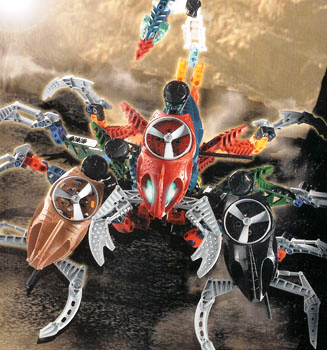
The Zivon also needs to be mentioned as a gigantic Level 12 Insect Rahi, meant to be the final boss Visorak. I’ve cooked up a nice little plan to make this one a Ritual Monster summoned not by a regular Ritual Spell, but rather by the Rhotuka effect of the Visorak Kahgarak – exactly the way it’s canonically called forth from the Field of Shadows. That’s not exactly compatible with generic usage, however, so another reason I’d honestly prefer the Visorak sectioned off in their own DARK Insect corner.
Level 3 and 4
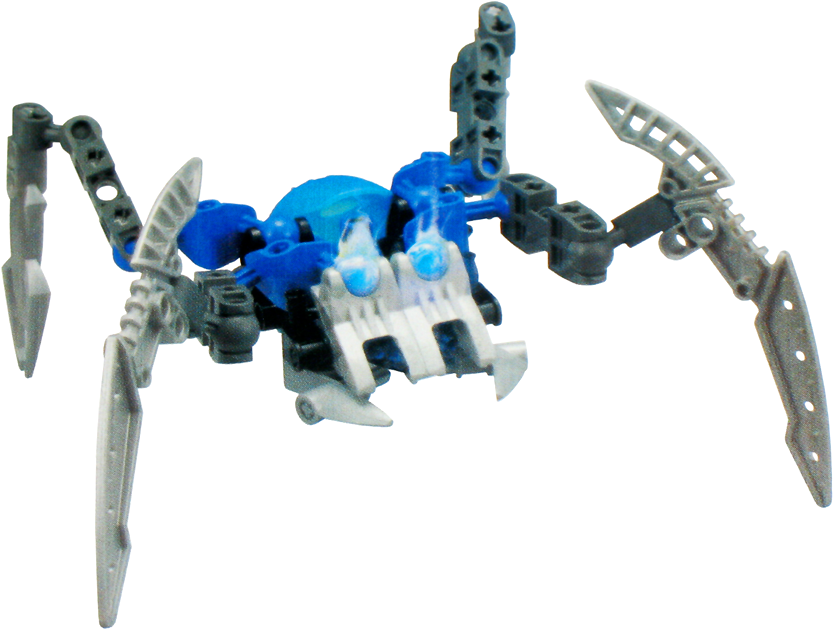
The only(!) Level 3 Insect Rahi on record is the Dagger Spider, found in the Green Belt of Voya Nui and built as a tiny little combiner model. Incidentally, the latter is a quality it shares with the Kirikori-Nui, so maybe it could be another low-Level Synchro? Effect-wise, their method of attacking involves feints, so maybe similar mechanics as with Utopia + Double or Nothing could be applied.
Level 4 includes the Visorak and some other DARK Insect stuff mentioned previously, but also the Sea Spider. Which is technically still connected to the Visorak, but since it’s one of their natural predators and unlike the nocturnal Metru Mantis has nothing to do with darkness, I can’t really justify shoving it into DARK. Not sure what to do with this one.
And that’s it for this section. Shockingly, there are practically no Insect Rahi I would place at these Levels, so unless I find other stuff to up-/downgrade or come up with a very unusual playstyle, there might legitimately be no choice but to let the Visorak mix with the general Insect pool after all. But even then, that would mean Insect Rahi only really start working in 2005 …
Level 5 and Higher
After the drought in the middle Level range, it’s surprising to see that quite a few oversized Insects can still be found at the higher Levels.
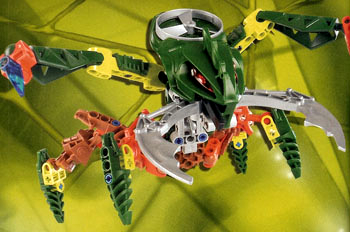
One particular subcategory I’d like to start with are those that have “Flip” listed as a potential subtype: Archives Beast, Tunnel Stalker, and Chute Lurker. These three share the common trait of being ambush predators, which is something I might yet devote a separate article to since it applies to quite a few Rahi and has some interesting ways to be implemented in card form. One possibility being that we make them Flip Effect Monsters, and since they’re all pretty big and high-Level, they’d probably Special Summon themselves face-down as well. Also, all three of these could have different Attributes (Beast DARK, Stalker EARTH, Lurker WIND/WATER), which is always nice for variety.
Outside of the ones connected to the Visorak, there’s some further big DARK Insect Rahi. The Subterranean Worm set to release in BPEV is probably going to be support for the Rahi Nui since that’s the main focus of that expansion Rahi-wise, but if it really does end up an Insect, it could be generically useful enough to also include in the broader strategy of the Type. Protodax and Fenrakk Spawn appear in Voya Nui and are both related to the guardians of the Ignika (the former directly, the latter indirectly), but again, generic usefulness in an Insect deck may be possible.
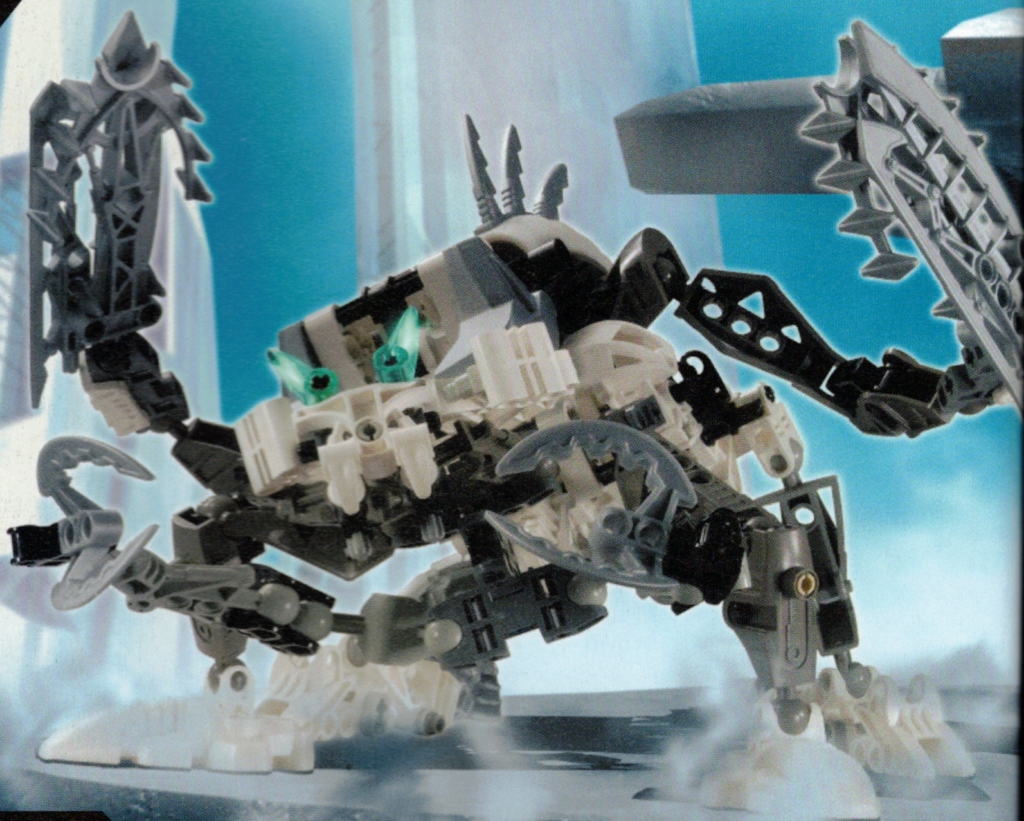
With the WATER Attribute, we have the Frost Beetle, one of several creatures closely connected to Ko-Metru’s Knowledge Towers (maybe a multi-Type subtheme/engine is hiding here?). Their thing is that the whole species got more intelligent by consuming the Towers’ Memory Crystals and integrating the information therein into their hivemind, which is … cool, but doesnt quite give me any functional ideas until I’ve figured out what Knowledge Towers do. In-game, I mean.

The magma-shooting Catapult Scorpions are FIRE Insects for a rather obvious reason, and since they look like significantly beefier Nui-Jaga, their Level is noted as up there at something along the lines of 8. Considering that they are explicitly super aggressive in addition to their size, they’re probably the most straightforward choice for a big game-ending Insect Synchro boss monster.
And if you want to go even more huge, consider the Troller, a worm stated to have a mouth “large enough to swallow a city block”. That would suggest it can’t possibly be anything below Level 12 as noted in the spreadsheet, but at this point I’ve practically dropped that idea for two reasons. One, Krahka transforms into one while fighting Roodaka, and I just see no way that scene could logistically work if their size was really as described. And two, from what we’ve seen so far, there’s really no way an Insect Rahi deck could support a full-on Level 12 boss monster. So we might go a bit smaller with this, maybe a more defensive option in the same weight class as the Catapult Scorpion (though it also doesn’t feel entirely right to group these two together).
Conclusions
Quite possibly the strangest Type yet. They’re either tiny or gigantic, with very little in the mid-Level size range, which leads to them almost completely missing certain crucial components of the Rahi playstyle as it has been implemented so far. The main redeeming factor in that sense are the Visorak, but they’re kind of busy doing their own thing and also don’t show up until a while later in the story.
It might therefore be necessary to step out of preconceived notions about Rahi card design a bit further than I’ve done in previous Type analyses. Beasts were a Pendulum/Synchro deck with a beatdown focus while Fish & co were a Pendulum/Synchro deck using more effect-based means of board control, but maybe Insects don’t necessarily have to be Pendulums or Synchros in the first place. Especially the latter is kind of inconvenient for a deck full of low levels anyway, unless we’re talking about teensy utility Synchro Monster like the Kirikori-Nui. For actual boss monsters, it could very well end up being the case that Insect Rahi instead put out a Link, a Rank 1 or 2 Xyz, or even an easily searchable Main Deck monster. Maybe the Level 2s won’t even be Tuners or handtraps if both of those features don’t synergize well with everything else.
Of course, once the Visorak and their relatives/allies/enemies do appear, the potential for a more conventional Synchro strategy does increase significantly. I am, however, still leaning towards placing those into a more isolated section as DARK Insects, so if the main Insect Rahi deck should use them, that would require an unusual degree of DARK acceptance on that end. I think this is realistically achievable by just making sure the Visorak never apply any locks that extend beyond the Type and keeping their interactions with the “Visorak” archetype and the DARK Insect typing strictly positive, so you can still put them in a non-DARK deck to use some of their features (though they’d obviously be more powerful in their dedicated strategy). This special mixing of Attributes could then be yet another strange feature of Insect Rahi compared to other Types.
More generally, I think “weird kinds of variety” might unexpectedly wind up being the niche for Insect Rahi, judging by these last two points. Having stuff like Links, Xyz, low-level Synchros, Main Deck bosses, and an entire DARK sub-archetype in the toolbox would probably provide ways to work around certain things regular Rahi decks might struggle with. And in that sense, having the weirdness of Insects also be splashable to some degree should be very healthy for the versatility and resiliency of Rahi as a whole.

